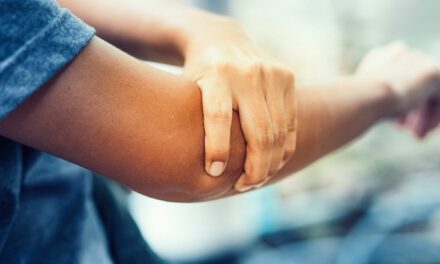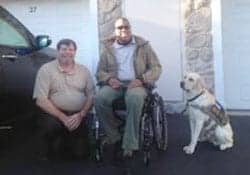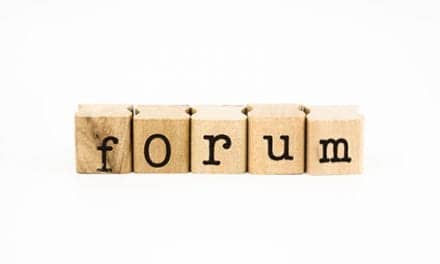In an underserved area of the rural heartland, aquatic therapy raises up a new crop of patients
by Elizabeth McDonald, CPTA, BSPTA, CCES, and Rebecca Baker, PT, DPT, CCES
Access to healthcare can be difficult for those who live in rural America. And, for individuals who need any type of specialty care, getting access to that treatment in a sparsely populated area can be extremely challenging. At Gove County Medical Center, located in the northwest Kansas town of Quinter (population approximately 900), an aquatic therapy facility was installed as part of a planned transition to improve the local population’s health and access. It was an idea introduced to the hospital’s administration in the early 2000s and brought to fruition after extensive research, questionnaires, discussions, and a tax income credit through the state.
This one-half-million-dollar project was launched to meet the needs of the local community. It would allow individuals who live in the local area to remain in the county to receive care but also draw patients from surrounding counties to avoid traveling long distances to larger cities. Building an aquatic facility also allowed the medical center to offer a diverse and novel therapy. At the time the aquatic therapy facility was built, the closest aquatic therapy provider was 60 miles away; thus, making access more attainable for many in this small county and surrounding area.
Service Area and Demographics
This small community with a strong agricultural background has 350 farms and a total of 119 employers. The population for Gove County has an estimated 2,636 people, according to the 2019 census, with 24% of the population age 65 years and older.1 Gove County Medical Center has five physicians and one nurse practitioner; their presence helps attract patients from surrounding counties and positions the center as a leader in healthcare.
Gove County pushes out across an expanse of farmlands, which can make it a hardship for some individuals to travel between towns. Expanding the hospital’s services locally has helped ease some of the difficulties associated with lengthy travel, including providing elderly individuals closer access to aquatic therapy services. Unlike urban areas where taxis and ride-sharing services are commonplace, Gove County has only one county transportation van, which can limit access to care for individuals who cannot provide their own transportation. These limitations can cause a considerable hardship for medical visits.
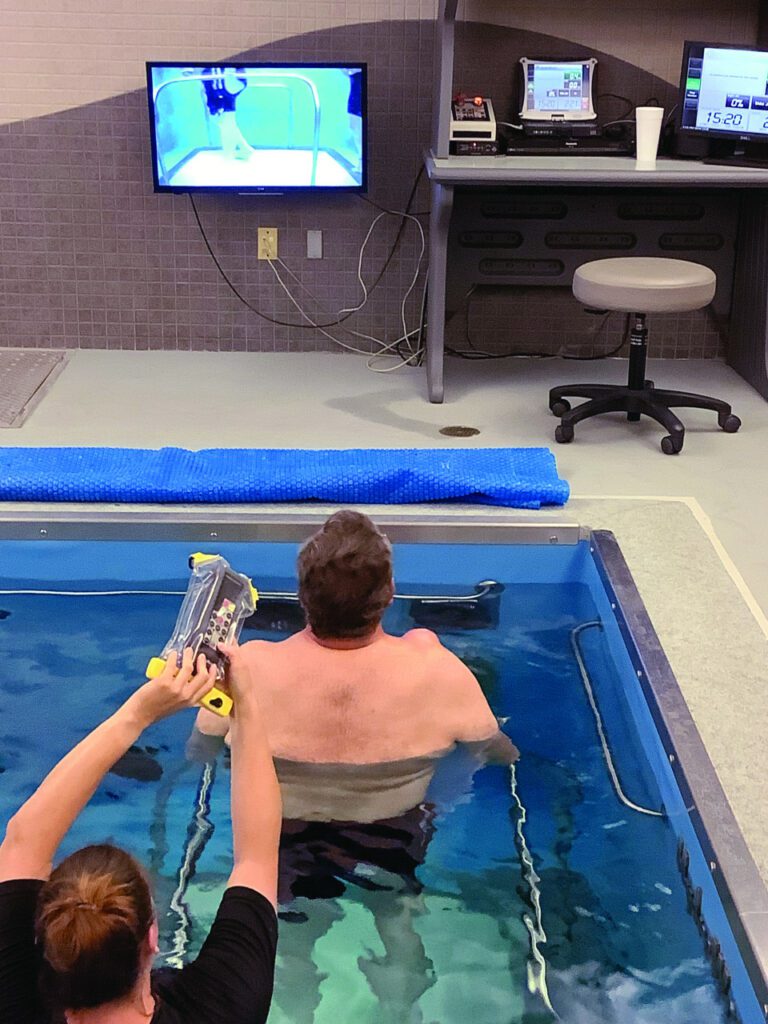
Creating with an Eye On Function
The pool facility began to take shape in a planning stage when design decisions were made about functions considered essential to the area’s patient population. Many options were available from several manufacturers. However, the decision ultimately was made to have an underwater treadmill with two removable handrails, side rails, massaging jet with hose, and two resistant jets. Two cameras that can analyze gait from an anterior or lateral view were also determined to be “must-have” equipment, in addition to a video recording option therapists can use to demonstrate improvement to patients.
For patients who are unable to go up and down the steps, the center integrated a total body lift that uses water pressure to lift the patient in and out of the pool. The device also provides a chair lift that enables the patient to remain sitting in the water if unable to stand independently. The valve to raise and lower the patient can be operated above the water or in the water for patient safety and convenience.
Various tools are used for exercise during their sessions. Therapists utilize floats, rings, weights, steps, gloves and barbells. Closed and open web gloves, different sizes of rings, weights, and barbells are all used for various progression of exercise as well. Starting with small to large objects or open to closed web would be the natural progression as well as slowness or quickness of speed with the body movement. Keeping in mind that the person’s body weight also makes for a useful tool in the water. Remembering core workouts in the water are also very essential and useful for any diagnosis or condition.
Laws of Physics That Heal
The aquatic environment offers many properties that are not available on land. Density, buoyancy, hydrostatic pressure, viscosity, and thermodynamics are among those properties. Although the human body is quite dense and composed mostly of water, its density is only slightly less than that of water. This allows the body to be pushed upright in the water by a force equal to the volume of the water displaced.2 Hydrostatic pressure is related to the density and immersion depth that aids in reducing edema of the injured body part. According to Comprehensive Aquatic Therapy (3rd edition, 2004), water exerts a pressure of 22.4 mm Hg/ft of water depth, which translates to 1 mm Hg/1.36 cm of water depth. Thus, when a person is placed in water at a depth of 48 inches he or she is subjected to a force equal to 88.9 mm Hg, which is just slightly above the normal diastolic blood pressure.
As a person immerses in the water the water is displaced, creating the force of buoyancy. This force helps the offloading of the joints immersed. The more the body is immersed, the offloading of the joints is increased. At shoulder height, the body is approximately 85% offloaded, allowing for decreased weight-bearing and the ability to function and move easier and with less restriction in the water. This also allows anyone with weight-bearing restrictions to begin possible gait earlier in the water versus on land.
The viscosity of the water relates to the amount of friction specific to the fluid during motion. An extremity moving in the water is subjected to the resistive properties of the water, causing a force and turbulence in the water. With this in mind, with increasing speed, the resistive properties increase. To overcome the drag force of the water, eight times the power is required to actually double the speed of movement. However, when at rest, there is virtually no resistance to the water, which is effectively able to “relax” the body.
The thermal properties of the water can begin to have a beneficial effect the moment a person enters the water. The physiologic effect can begin immediately as the person feels more “relaxed” in a warm and nurturing environment. Typically, a warm water environment can cause an increase in heart rate that parallels with the rise in core temperature, from the water, and blood pressure tends to decrease. Cardiac output is increased as well in the warm-water environment. The relaxation effect and pain improvement go hand-in-hand with warm water aquatic therapy. Pool temperatures need to be regulated according to an individual’s condition, since warmer water may cause people who are affected by conditions such as multiple sclerosis and lupus to become quickly fatigued.
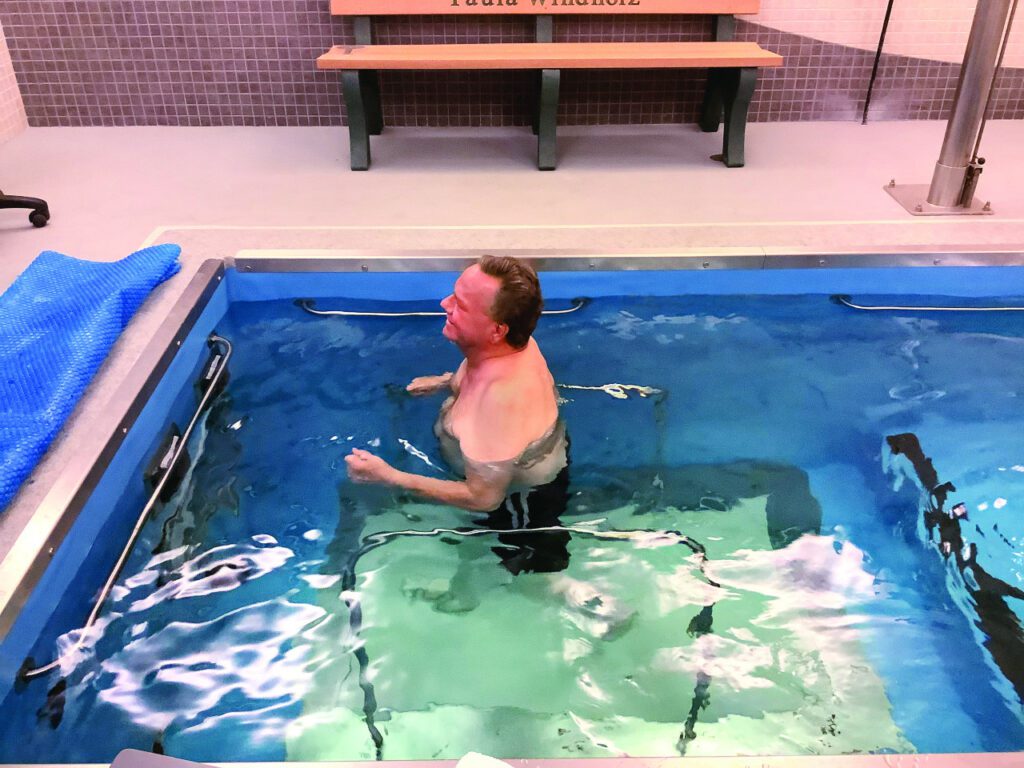
Compliance
Patients with a range of diagnoses can benefit from aquatic therapy, from pre- and post-surgical orthopedics, to arthritis, pain, athletic injury, functional impairments, and many others. Once in the water, patients almost immediately begin to experience less pain and have better motion. Therapists must be mindful to not allow patients to overdo it, since they most likely will feel the effects of overexertion later. Patients tend to feel so good in the water they want to do more. However, exercises must be done cautiously to prevent excessive soreness. The center’s patients have reaped many benefits from the water and come from miles around to be treated. A local farmer wrote to the center with this observation: “Getting back to the therapy pool, it’s an awesome rehabilitation tool! Especially in 91-degree water, while walking on the under-water treadmill!” Another recent patient stated, “We are blessed in our small community to have access to an aquatics program.”
Fear of water can be an obstacle to treatment. However, if patients try the water and experience the benefits for themselves, they can usually overcome that fear—or at least better manage it. Very few people who come to the medical center for treatment have refused aquatic therapy due to fear.
In addition to fear, body image may also create an obstacle to treatment. The therapy staff tries to limit this concern by working one-on-one with each patient and always in the pool to ease their worries. Life vests or floats are also available for them if needed. There is never another patient in the pool with them, and at times, we have shut the camera off if it is not a necessity and the patient has legitimate concerns about this. The staff’s number one priority is patient safety and that person’s happiness during his or her session, since happy patients tend to improve more quickly.
Wise Investment
Gove County Medical Center’s aquatic therapy facility has been a superb investment, and there is no question its patients have benefited from the ability to access pool-based care. Looking ahead, the center hopes to expand its aquatic services by offering offer self-pay aerobic classes and group sessions. While establishing aquatic therapy as a service for this rural area required hard work and dedication, the tremendous progress it has helped fuel for patients has been fulfilling for stakeholders throughout the community. The medical center’s therapy department continues to explore treatments and activities this resource provides as a way to continue to grow within the community and surrounding areas. RM
Elizabeth McDonald, CPTA, BSPTA, CCES, has worked for 26 years at Gove County Medical Center, Quinter, Kan, obtaining her Bachelor’s degree in 2013. She is the Director of Therapy Services overseeing PT, OT, ST, Cardiac Rehab, and Cancer Rehab services.
Rebecca Baker, PT, DPT, CCES, has been a physical therapist at Gove County Medical Center for 4 years and has specialized in Women’s Health and Dry Needling. For more information, contact [email protected].
References
- United States Census, QuickFacts,Gove County, Kansas, 6/3/2021. Available at: https://www.census.gov/quickfacts/fact/table/govecountykansas,KS/BZA210219
- Becker BE, Cole AJ. Comprehensive Aquatic Therapy. Pullman, WA. Washington State University Publishing. 2010;24-25:390.

